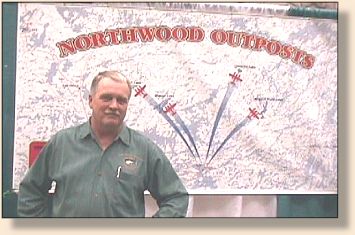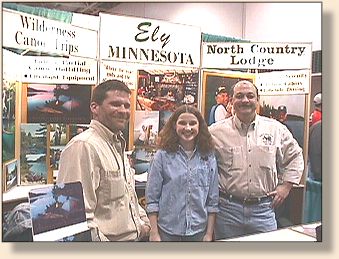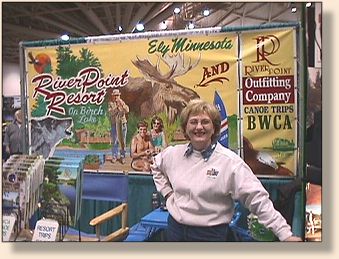|
Got an e-mail from a member of FAOL, inquiring on someone to
help with casting instructions in the Twin Cities. The only
person I would consider is Bob Nasby, who was going to be at
the Northwest Sport Show, in Minneapolis. So got in my car,
and went to the show Saturday. Normally I would not go because
it is mostly boats and stinky bait anglers.
The Sports Show is humongous, and lots of booths and displays.
Resorts, Fly-Ins, Boats (lots of boats), very little on fly-fishing.
Upstairs at the convention center, was one small area for fly-fishing.
G-Loomis was there with a booth, and so was Scientific Anglers,
and some local groups that were showing how to tie flies. There
I found Bob Nasby, doing casting instructions and demonstrations
for Scientific Angler's, sorry no picture.
I also ran into my old fly tying mentor Scott Nordby, tying flies.
It was great to see him again. Just another of the many fly anglers
sharing the knowledge and joy of fly-fishing with anyone who
wishes to learn.

I headed back to the main floor to go looking for something
that would be of interest to fly anglers. And here are four
booths that struck my interest.

"Drift Control®" Sea Anchors, for those who Stillwater fish from
boats. They are a Minnesota Company. I liked their product,
it is quality made. They have the sea anchors in three sizes
40-inch (12 foot-to-15 foot boats), 50-inch (16 foot-to-18
foot boats), and 60-inch ( 19 foot- on up boats). Bart Rosen,
was very helpful, explaining all the ways that a sea anchor
will improve a fly anglers fishing experience, Stillwater
fishing from a boat. To locate the dealer nearest you, or
to find out more on Drift Control ® Sea Anchors, their website
is (www.driftcontrol.com).

At the "Northwood Outpost" booth, Clay Dowsett (owner) was friendly
and speaks fly-fishing. He does fly-ins from Sioux Lookout,
Ontario. He has cabins on four different lakes, north of Sioux
Lookout that are from 30-to-50 minutes flight time. Modern
Cabins and excellent Walleye and Pike Fly Fishing. They supply
almost everything you need as part of the cost. Their website is (www.northwoodoutposts.com).

Next booth I found interesting is "Big Lake Wilderness Lodge, &
Outfitters", at Ely Minnesota. Big Lake Wilderness Lodge, is
owned/operated by Tom Ingison. They are outside the BWCAW
(Boundary Waters Canoe Area Wilderness) in the Superior
National Forest, near the Echo Rail Entry Point. Big Lake
Wilderness Lodge and Outfitters can be located at (www.biglakelodge.com).
Tom also has North Country Lodge on Moose Lake/Basswood Lake at
Ely Minnesota. Besides having excellent lodging, Tom Ingison also
has outfitting and guides service available at Border Lakes
Wilderness Canoe Trips (www.borderlakes.com), if you really
want to go camping in the BWCAW & Ouetico Provincial Park,
and really experience the wilderness. There is excellent
fishing for Walleye, Pike, Trout, Smallmouth Bass and Lake
Trout in the BWCAW/Ouetico. In 1940 Smallmouth were stocked
in what was to become the BWCAW, and can get up to 4-to-5 pounds.

River Point Resort & Outfitting Company is near Ely Minnesota.
Talking with Jane Koschak of River Pont Resort, they are on
Birchwood Lake, where the Kawishiwi River joins in the Superior
National Forest, with an entry point into the BWCAW. River
Point Resorts has modern accommodations. They also do outfitting
for the BWCAW/Ouetico area. Their website is (www.elyoutfitter.com)
Another outfitter for the BWCAW/Ouetico area, is Superior-North
Outfitters, located at the end of the Gunflint Trail (out of Grand
Maria Minnesota) on Saganaga Lake. Another entry point into the
1 million acres that make up the BWCAW. Superior-North Outfitters
can be found at (www.superiornorthoutfitters.com). I forgot
to take a photo of their booth.
You might wonder why I am focusing on the BWCAW/Quetico area?
Back in the 1940's and 1950's. A group of people fought to
save the last region in Northern Minnesota that had not been
destroyed by private interests. A truly wilderness area, that
had no roads. This group was lead by a man named Sigrud Olson.
Sigrud Olson also wrote many books on the Wilderness Experience.
May I suggest two that Sigrud wrote, The Singing Wilderness
and The Listen Point. It is very rare a person can
put into words that which is so hard to describe.
Sigrud Olson suffered greatly because of his quest to save a small
portion of the wilderness. If Sigrud Olson had not stood firm,
while President of the National Park Association, we would not
have the Boundary Water Canoe Area Wilderness today. He was
hated by many in his hometown of Ely Minnesota, where he had
been the President of the Ely State Junior College. If you are
ever in the Ely area, there is a museum dedicated to the work
of Sigrud Olson, and you can visit his "Listen Point," where he
would seek out the Singing Wilderness, and hear her voice.
Sigrud was also involved with the stocking of Smallmouth Bass
into the BWCAW. Today these Smallmouth Bass are truly the
ledgendary Bronzebacks you may have read about in old fish
stories of days of yore. Today we have an area with no cabins
or roads. Motor vehicles and motor-power boats are banned.
Even seaplanes are not allowed into the BWCAW/Quetico area.
You don't know the true meaning of being alone on a body of
water, or how loud silence can be. And to hear Timber Wolves,
howling at night with their serenade to the moon, hearing the
haunting calls of the Loons. To be in the wilds where the
animals are the locals, and you are the visitor. It is an
experience all should enjoy at least once in their life.
In the wilderness, you will find yourself whispering, as
if not to disturb the silence.
The BWCAW is designated a Wilderness Area. State and National
Forest are harvested for their lumber. State and National Parks
are open to the public, with buildings, roads and tourist centers.
BWCAW is the only designated Wilderness Area in the lower 48 States.
The number of groups allowed to enter is restricted, with a
maximum of 9 people/4 canoes per group. Everything taken in
must come back out and food items are regulated as to packaging.
This is not a park, so if a fire starts, it is not fought to
bring under control. Three years ago, there was a violent
storm in the BWCA. Straight-line winds which approaching
100 mph, a large area had massive damage to fallen trees.
These trees will not be removed or salvaged by lumber companies.
Instead there will be a controlled burn to do what nature does
best to recycle the nutrients back into the environment. This
concept of a Wilderness Area is foreign to most people, but is
one that all should experience at least once in their life. ~ Parnelli
|











